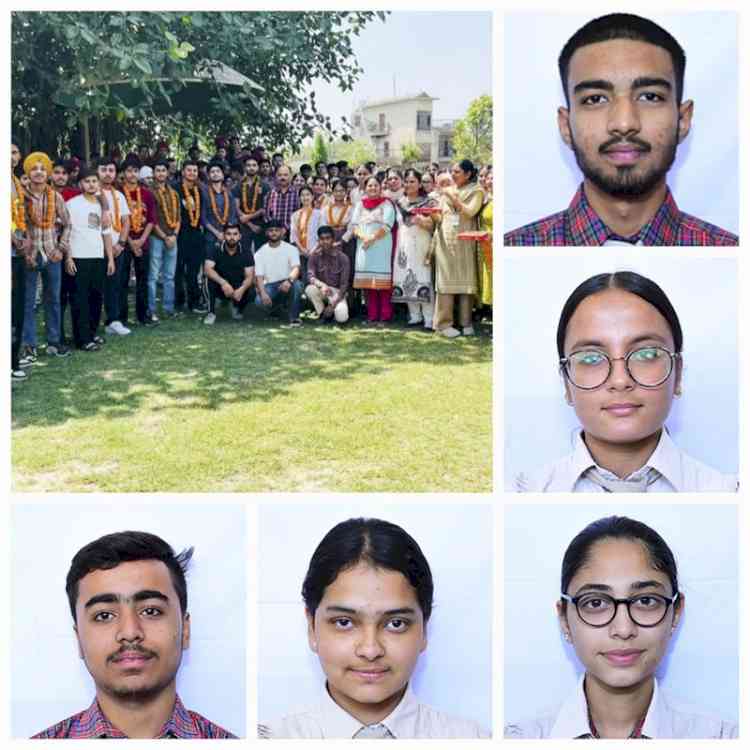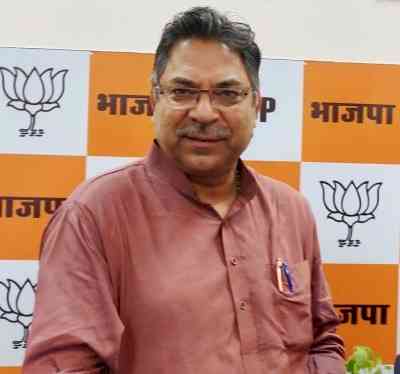AVTAR Group launched VIEWPORT 2016 Report
Author(s): City Air NewsChennai, May 9, 2016: AVTAR Group, one of India's leading talent strategy and Diversity & Inclusion consulting firms today launched the VIEWPORT 2016 Report with the theme "Roadmap to Gender Balance: Compendium...

Chennai, May 9, 2016: AVTAR Group, one of India's leading talent strategy and Diversity & Inclusion consulting firms today launched the VIEWPORT 2016 Report with the theme "Roadmap to Gender Balance: Compendium of ideas by corporate leaders in India towards improving women’s workforce participation." The report is a collaborative effort of over 100 HR leaders from across industries and their standpoints on the critical enablers for improving Women's participation in the workplace.
Over the last several studies we undertook on women’s careers – pointers aplenty emerged – that organisations can instantiate enablers for women’s careers in the form of flexible working architectures, mentor networks, on-site crèches and skill building programmes; that it will help if women professionals themselves are more intentional about their careers – seek out mentors, build rapport with their managers and discuss careers with their friends. But we knew we weren’t done and far from being dusted! And we knew we were right when a 2014 study commissioned by ILO on developing economies observed that the ability of a woman to be part of the labour force is impacted by 6 critical factors, namely, 1) Level of economic development 2) Educational attainment 3) Social dimensions, such as social norms influencing marriage, fertility, and women’s role outside the household 4) Access to credit and other inputs 5) Household and spouse characteristics 6) Institutional setting (laws, protection, benefits) and reaffirmed our belief in the need for more exploration.
The recent trends indicate that women are indeed leaving work and corporate India is in fact on the ‘backtrack mode’ on the road to gender balance. The reasons are out there for all of us to see and most organisations are in the know. To reverse these trends and continue the onward journey, it is important that collective actions are taken by all change makers in the country. The compendium of ideas from corporate leaders echoes the same belief. AVTAR VIEWPORT 2016 presents, a comprehensive set of ideas garnered from 100 diverse leaders of corporate India to the end of improving women’s workforce participation rates in the country, are presented.
As we put together this compendium of ideas from thought leaders in India – each of whom were visionaries in their league - we realized that the complexity of an IWP’s career system leaves space for many more interventions– by the Government in its legislative capacity; by the media (social, physical et.al) by virtue of its ability to instigate grass root level changes and by the social ecosystem in terms of conditioning young girls and enabling their aspirations. To set the context, this report takes you through the evolution of women’s workforce participation in India and critical observations with regard to Indian women’s career patterns over several years. The heart of the report is the comprehensive list of ideas as proposed by the corporate leaders who astutely believe in the vision of gender balance. The several social, economic and business imperatives of more women in the workforce - the shared end goal of each one of the action points proposed serves as the fulcrum to this effort of ours.
Government:
1. PROVIDING EQUALITY IN ACCESS TO EDUCATION AND TRAINING
As education plays a very critical role in laying the foundation for a flourishing career, it is important that women are given equal access to all opportunities to educate, train and develop themselves for their career pursuits. Moreover education will also empower girls and help them make critical life decisions. To this end, here are some proposals as put forward by the leaders:
• Make it compulsory to educate all girl children up till their graduation. Girls who hail from economically backward classes may be exempted from paying fees starting from high school (8th standard). This policy should be inclusive of all women in the country – those in metro cities to those in the remotest of villages.
• Ensure that premier institutes of technical/professional education (such as the IITs) attract more women. Today these numbers are too low. This may be done by providing more training opportunities for young girls throughout middle and high schools to prepare them for the rigour and standards set by such institutes.
• Initiate formal vocational skill development programmes for women to make them economically independent and utilize their skills to earn a living
2. FORMULATING STRONGER LAWS ON WOMEN’S WORKFORCE REPRESENTATION
Legislative reforms that encourage organisations to hire more women and engage with their current women employees can provide a great boost to the women’s workforce participation in the country. This will also ensure that equality in access to opportunities is guaranteed to women and they join and stay in the workforce in large numbers. As keen observers of the laws of this country, here are a few pointers from industry leaders with regard to this concern:
• Provide a highly publicized tax rebate on small and medium enterprises which employ women who are re-entering the workplace after a break of at least one year (To improve minority employment, many governments world over have instituted tax rebates to encourage businesses to hire from minority groups.
• Similar to the SEBI directive on a quota of one female director on the board of every listed firm, women’s representation at each organisational level must be expected to be at a certain pre-decided percentage. In case of non-accordance to the same, penalty may be imposed
• Provide option to women to extend their retirement age beyond the normal retirement age given the years likely lost to childcare and their enhanced life expectancy compared to men
• Provide for 20% reservation for women in employment for both in the public and private sectors
3. ENSURING GENDER WAGE PARITY
Wage parity is a metric reflective of the gender equality of India as a society. Surveys have shown that gender pay gap between urban males and female workers in India is today at almost Rs.70/day. While male wages on an average male in urban India is Rs. 377.16/day, that of the urban female is Rs. 308.79/day. Many leaders felt that ensuring gender wage parity is critical in enhancing women’s workforce participation and the following measures may help achieve the same:
• Ensure that there is equal pay, conditions and performance assessments based on output that professionals create and pay is not in relation to the number of hours they clock work
• Encourage organisations to revamp performance assessment metrics for women who are back at work after a career break (such as maternity break) to minimize the wage penalty they might otherwise have to incur
4. PROVIDING FINANCIAL SUPPORT TO WOMEN
Women-owned or women-run businesses generally tend to hire/employ a greater number of women:
• Provide special financial facilities/loans for women entrepreneurs who pass government approved skill development programs and for other professionally qualified women
• Provide women with the bank finance to start a business. The environment must be safe and non-threatening to an aspiring woman entrepreneur. It is suggested that there may be one woman loan officer in every branch and NOT necessarily a women’s bank to execute these loans
• Additional tax breaks for women entrepreneurs
5. INCREASING MATERNITY LEAVE AND CHILD CARE LEAVE MANDATES
As already pointed out, it is post-maternity that a significant number of Indian women drop off the workforce. Disintegration of joint families in urban India and the lack of reliable and affordable day care centers imply that young mothers do not have family support or hired support to take care of their infants during the early months. To encourage more women to return to work after having children, leaders propose that the following measures may be considered:
• Extend the current mandated maternity leave policy of 12 weeks of paid leave to at least five months. This may be followed by a short period of leave without pay (up to six months) and provision for working flexibly for up to another six months time
• Provide financial incentives for organisations which have extended maternity leave policies. Otherwise there will be greater caution in hiring women. Other incentives for hiring women who are returning to the workplace after career breaks may also be considered.
6. ENSURING PROVISION OF AFFORDABLE AND RELIABLE CHILD CARE
Based on results of several studies in India, women often tend to quit or not progress in their career after starting a family. For the record, a survey of 1,000 women working in the capital, Delhi, and its neighboring areas in 2015 found that only 18-34% of married women continued working after having a child. In a national survey by LinkedIn 60% Indian women said they will slow down their careers once they have children. Traditionally in a country like India, it has been women’s responsibility to raise children. Enabling women to progress in their careers simultaneously while raising children will be a critical enabler to women careers. To this end, the following measures may be taken:
• Promote private enterprises to excel in the area of affordable, reliable and cost-effective childcare
• Create an accreditation process for day care centers that ensure that families feel that their children are in safe environments
• Start government funded but privately run top-quality day care facilities
7. ENCOURAGING BUSINESS SPONSORS
For the goal of greater women in employment to be attained, it is important that every organisation that is a potential employer of women be encouraged to contribute to the same. The encouragement may be provided in the form of:
• Recognition for businesses that have initiated successful practices for retaining and engaging women employees
• Tax rebates for organisations that have initiated successful practices for retaining and engaging women employees
8. SKILLING OF WOMEN RETURNING POST A BREAK – Part A
Presently, there is very poor focus on re-skilling women who are returning after a break in career. There are 1.5 million Indian women, most with commendable experience records wanting to make career comebacks. To enable their career returns:
• Create a national registry of women on career breaks, collating data of women employees who quit from small, medium and large enterprises
• Create organized networks/registered bodies wherein returning women (currently on breaks) can register for employment
9. IMPROVING INFRASTRUCTURAL SUPPORT
Indian women are not only responsible for child care but also for the care of elders in the family. Strengthening childcare and eldercare facilities in major employment hubs like cities, industrial hubs, etc including providing financial incentives for NGOs and private sector enterprises that are willing to set up and manage them can encourage many women who have care taking responsibilities to avail of these facilities and continue working, according to some leaders who shared their views on the same.
Organization:
10. ENSURING SAFE AND SECURE WORK ENVIRONMENTS
In a day and age where an increasing number of crimes are reported against women in the country, it is important that they are ensured of safety at their places of work. More importantly, today’s market place demands us to work in different time zones to support global projects. Women are deprived of many of these opportunities due to a lack of a safe mode of commuting to or from work at odd hours. Safe commute and security at their workplaces can not only prevent them dropping off the workforce, but also improve their productivity. To quote what a few leaders felt about means to achieve the same:
• Enforce stronger laws to encourage safety for women
• Make it mandatory for all organisations to have formal anti-sexual harassment policies
• Direct organisations to provide for transport of women employees at late or early hours in cabs/buses driven by drivers with verified backgrounds.
11. CREATING FLEXIBLE WORK ENVIRONMENTS
Flexible working refers to alternate arrangements of work that allow professionals to work at their time or place of convenience. Some of the most popular forms of flexible working are work from home, flexible working hours (professionals can work during time slots most suited to their schedules) and part-time work.
• Formulate policies to enable workplace flexibility such as that for work from home, flexible working hours or part-time working.
• Revisit and review labour policies to facilitate working reduced hours, flexi working, telecommuting (remote working) – to remove barriers between full time and part time, short term employment
12. SKILLING OF WOMEN RETURNING POST A BREAK – Part B
As part of the efforts for the same, the organizations can do the following:
• Conduct skill-building workshops through these networks either free or for a nominal fee. These workshops may be customized to meet the skill demands of the labour market (technical and soft skills) at any given point of time. Additionally, there could also be targeted sessions for addressing specific issues faced by second career women such as confidence gaps, need for better work-life integration, sensitizing their families on the importance of them returning to work etc.
13. CULTIVATING WOMEN LEADERS
The biggest inspiration for a woman aspiring for career progress comes from women leaders who are role models and whose success stories are worth emulating. Recognising women leaders and making their journeys known can motivate young women in the threshold of their careers to follow their paths. Leaders suggest that some of the measures given below can help realize the same:
• Treat women with as much respect as their male counterparts. Give them leadership roles and make them project managers.
• Ensure more representation of women at senior levels and boards:
o motivate seasoned women professionals to take on and be represented at core forums and break all attitudinal barriers in existence
• Create a pool of industry mentors - both men and women - for high potential women in leadership roles - to provide guidance and a sounding board to gain perspective as they grow their careers
• Create networks of senior women leaders and encourage young women to deploy these networks for career pursuits
• Recognise powerful women role models in the Public services / PSUs and make known their achievements
Educational Institutions:
14. CREATING INCLUSIVE ENVIRONMENTS AT EDUCATIONAL INSTITUTIONS AND ORGANISATIONS
An environment of inclusion where women are treated equally and respectfully is necessary for them to make strides in all their endeavors. This requires educational institutions and organisations to sensitise students/employees on gender equality and eliminate gender discrimination from the system. According to leaders, the following steps may take us closer to this goal:
• Initiate mandatory sensitisation trainings at educational institutions on gender differences and working alongside both genders
• Encourage mixed schools/educational institutions
• Include gender equality as a syllabus item for school students
Society:
15. CREATING EQUAL AND SUPPORTIVE SOCIAL ECOSYSTEMS
Socio-cultural conditioning in many families in India often results in girls growing up to be less intentional about careers. The gender bias and stereotypical notions on gender roles are unconsciously fed to young boys and girls who grow up to intrinsically believe in the ‘male-breadwinner, female-caretaker’ family model. For women to progress in careers, family support and support of all social ecosystems they are part of – both at an emotional level and at a physical level, is indispensable. To list a few thoughts from the leaders to address this concern:
• Educate a girl’s/woman’s ecosystem. A fair amount of insensitivity reflected by family and co-workers of women, a large part of which is rooted in unconscious biases and/or inability to appreciate the value women bring to work-place, deter the pace at which a woman makes career progress. Co-workers and many a times family need information, positive endorsement and pride to enable better work environment for women.
• Enforce gender equal positive norming and monitoring in the society
• Increase penalty for social evils against women/girls such as dowry and child marriage
• Sensitise the social fabric in India, wherein families need to encourage daughters to take up serious technical careers
• Enforce gender equality at home; sensitisation of mothers to achieve the same is critical
Media:
16. CONDUCTING GENDER SENSITISATION DRIVES THROUGH MAINSTREAM MEDIA
Being able to shed unconscious biases and prejudices against the opposite gender is critically relevant in the creation of a gender equal society. Just like the sensitisation drives on media against social evils or crimes on women, it is the need of the hour that informative, sensitive and responsible campaigns through mainstream media (that has a penetrative reach amongst the masses) are initiated by the Government and independent organisations to spread greater awareness on gender equality. To this end, here are a few measures that leaders felt that need to be taken:
• Create good quality online gender sensitisation workshops that can be widely disseminated to men and women to build awareness of some of the challenges women face at work and help break some of the conscious and unconscious biases in this space.
• Conduct gender sensitisation and awareness sessions/workshops/counseling at schools and colleges
• Televise the success stories of women leaders in Indian in a first-person, story-telling format
• Initiate an entire communication campaign which is around raising the ambition levels of women and changing stereotypes
• Use mass media to promote the idea of women at work, encourage women’s participation in the workforce and highlight its benefits

 cityairnews
cityairnews 
















